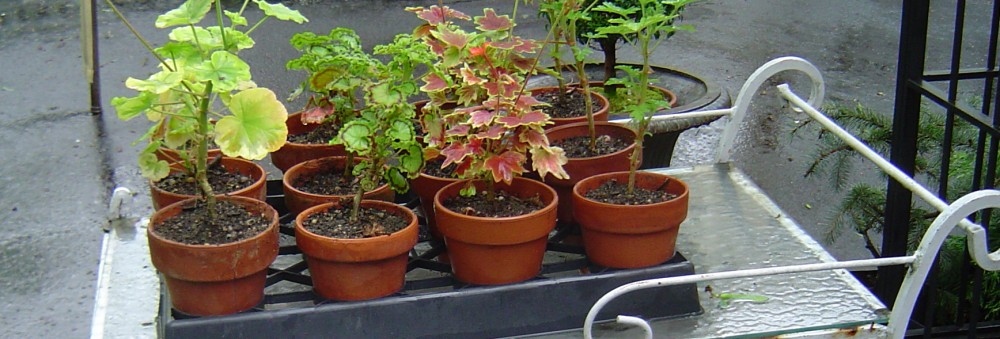I’ve always seen the garden as a natural laboratory and the gardener as the chief scientist or principal investigator. In the making of a garden, we are but creating something of our own ideas and vision. Under certain given parameters of geography, climate and such, the gardener attempts to come up with something that fulfills a human need. These are contrived spaces where nature is manipulated. And when the hypothesis is realized, the work is deemed a success.
In truth, sowing a seed is nothing but an experiment.
A gardener will tweak, adjust, change and alter things all the time. Improving and trialing plants, colors, designs, shapes and always pushing boundaries both literal and metaphoric. No two gardens are ever alike because conditions are never identical even on plots sitting side by side. It’s always about experimenting.
Trying a rose in a seemingly unsuitable location in front of the air-conditioning compressor only to find success because nobody else accounted for the ideal combination of light, rich soil and the healthy air circulation resulting from the compressor hard at work cooling the house.
Or planting apple trees in the perfect location but ignoring the big cedar tree on the adjoining neighbor’s plot. Apples abound but all affected by cedar rust. The fruits taste fine but don’t look great. An experiment with mixed results. I have personal experience here and I’ve learned to live with blemished fruit. Keeps me humble but well fed.
We experiment with watering, light/shade requirements, new plants, new combinations of colors and/or plants, locations, styles – every effort is a mix of knowledge, hope, risk and curiosity. That last factor is the very essence of the mind of a scientist. Curiosity – the more we have it, the better the gardening experience. It’s not really about the successes at all. Success feels good but like a drug, one just keeps wanting more of it. Failures teach much more. There’s real growth from learning from mistakes. But curiosity is what drives the whole experiment, Every single time.
Curiosity makes us ask questions – What if? How about? Will this work? Why?
This year, my biggest experiment was all about growing dahlias. I tried them in pots and in ground. The pots got a head start because they went into the greenhouse as soon as it was vacated by all the over-wintering plants. The ground however had to wait till it was warm enough.
The spot I’d thought would be good for planting dahlias turned out to be smaller and not as sunny. Still, the plants grew and bloomed. It became crowded though. The asters nearby became thuggish and encroached on the newcomers. Clearly, my first mistake was in ordering too many dahlia tubers. That was sheer greed. And beginners optimism.
I ran out of big pots and crammed all the remaining tubers into a space that was inadequate. The lilac tree on one side cast more shade than I’d realized. So it is quite surprising that I got a fair number of beautiful flowers. The site however was not attractive at all. Despite the staking, it looked rather messy. Okay, ugly.
The pots did well. They started early, got moved outside and grew handsomely. A couple of them got attacked by some bug but appeared to overcome the problem on their own. I was too busy traveling so failed to be diligent. Pots were also watered regularly by a drip system set up for all pots in our absence while the dahlias in the ground were left to Nature’s mercy. In both cases, they came through well. I understand from dahlia veterans that this was a difficult year. Intense heat and lack of rain affected when the plants started blooming. Commercial growers were uncertain about the harvest. Last Christmas, I’d been given a dahlia subscription for this year and the weekly bouquets came with a fair amount of filler blooms which I’m pretty sure was not part of the deal. There simply weren’t as many dahlia flowers this year. I personally did not mind. The farmer is not responsible for the weather and did their best to please the subscribers.
Overall, I learned a lot and was quite happy with the whole experiment. Furthering the experiment, to store the bulbs through the winter, I’m following the traditional rules to pull up the tubers from the ground, clean and air dry, then store in cool, dry and dark location. Checking periodically to make sure they hadn’t gone moldy or desiccated. The tubers in pots however are going as is inside the unheated basement. The plants have been cut down of course. But I want to see how those tubers do compared to their naked cousins. I’m also experimenting similarly with the Canna, dwarf banana and Elephant ears. Other than all the big pots really crowding up the multi-purpose basement, the investment is very minimal. But the pay off could be good! Shall report on how it all goes.
Additionally, I’ve all together abandoned the idea of replanting dahlia tubers in the ground. I simply do not have a really suitable spot. Instead, I’m going to put them all in pots and keep them in the greenhouse throughout their growing season. It’ll be the dahlia cutting garden under glass (doors open of course). They’ll get enough light, regular watering, good air circulation. We shall see if this pampered set up yields an abundance of flowers.
Hot house beauties of a sort!
Note: I’m very pleased to be participating in the KMAA ‘Members Best’ Art Show at the Katonah Library all through November. Please visit this exhibit – creativity abounds!
(c) 2022 Shobha Vanchiswar
[do_widget “Blog Subscriptions (Jetpack)”]




































































































































